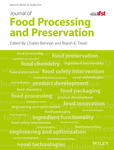Inhibitory activity of pigments in tomato on AGEs of food simulation system in accelerated storage condition
Abstract
Three types of main pigments, lycopene, Lutein, and β-carotene were extracted from tomato and analyzed by chromatography-tandem mass spectrometry (UPLC-MS). The inhibitory effects of the three types of pigments on the formation of advanced glycation end-products (AGEs) in a heated model system at 65°C were then studied by determining glyoxal, Nε-(carboxymethyl)lysine (CML), pentosidine, and fluorescent AGE assays. Three pigments showed good inhibition to glycation products. SDS electrophoresis images also proved that pigments can significantly inhibit cross-linked AGE formation in a time-dependent manner. Lutein and lycopene displayed the better inhibition activity on CML and fluorescent AGE than β-carotene (p < .05), especially lycopene showed almost twofolds stronger inhibitory activity on pentosidine and CML than β-carotene, this results were attributed to its efficient inhibition to active oxygen and open-loop structure of thermal resistance.
Practical applications
Many studies reported that plant-derived antioxidants are currently attracting greater research interest given their relative safety and comparable efficacy. Carotenoids are important natural pigments that contain a large number of conjugated double bonds, which give them good resistance to oxidation. Our results demonstrated that some important components of carotenoids could significantly inhibit cross-linked AGEs formation in a time-dependent manner. Using them, we successfully reduced the generation rate of AGEs in baked cookies, the inhibition rate of tomato pigment (2.74 mg/g) on CML and fluorescence-AGEs were 26.89% and 45.86%, respectively, in homemade cookies. Thus, tomato pigments or carotenoids as additives in food processing can effectively reduce the formation of AGEs and control the quality of products without affecting the value of commodities.
CONFLICT OF INTEREST
The authors have declared no conflicts of interest for this article.




